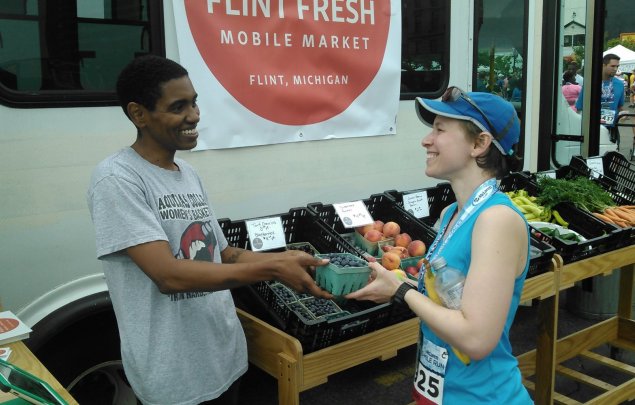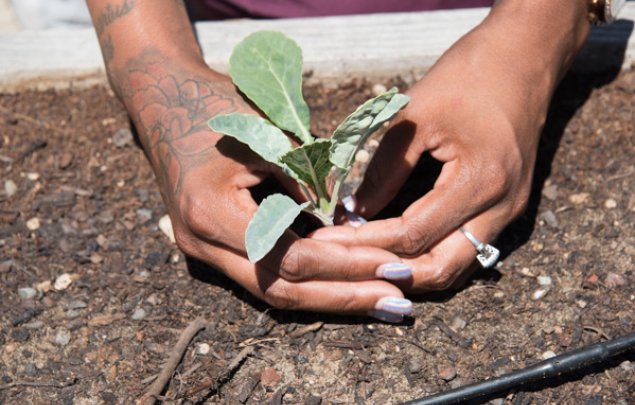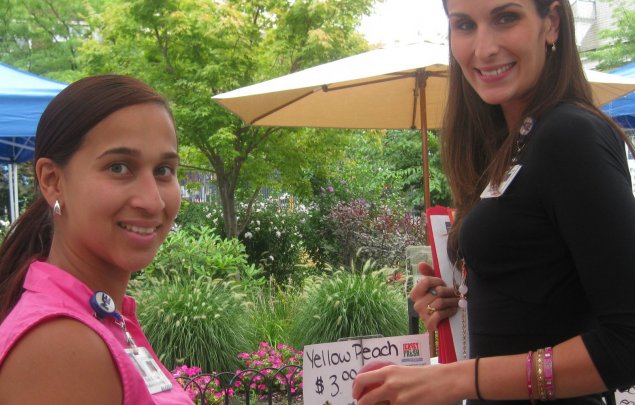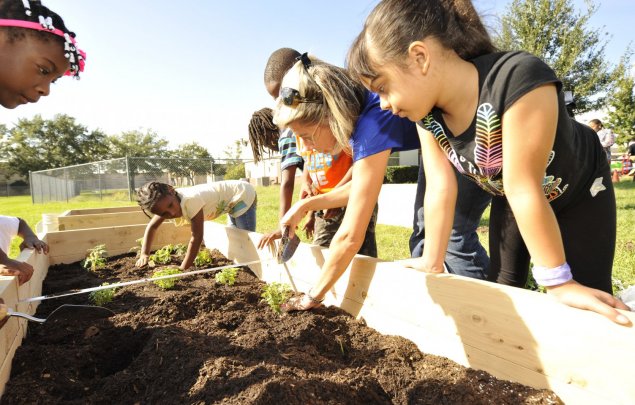Community voices leading to community benefit
Takeaways
- Significant resources were dedicated to gathering primary data on food needs in the community. Surveys were mailed to over a thousand households and more than 600 surveys were hand-administered.
- The results of this survey revealed one in three persons in the region were experiencing food insecurity.
- Three innovative food-access programs are supported by the hospital’s community benefit investments:
- Veggie Rx
- Gorge Food Security Coalition
- The Raices Cooperative Farm
- In 2016, the region was awarded the Robert Wood Johnson Culture of Health Prize.
Hospital Name: Providence Hood River Hospital
Hospital Type: Private, nonprofit, critical access
Hospital Size: Small (25 beds)
Geographic area: Rural
System/Network: Providence St. Joseph Health
Network coverage: California, Oregon, Washington, Montana, Alaska, Texas, New Mexico
Black/African American: 3.2%
American Indian: 1.5%
Asian Pacific Islander: 7.2%
Hispanic: 12.6%
White: 77.4%
Community health needs assessment region:
- Columbia Gorge region
- 5 counties in central north Oregon
- 2 counties in southwest Washington
Population: 84,23411
Obesity: 2 out of 3 are obese or overweight
Diabetes: 1 in 2 have chronic health conditions. 14% have diabetes.
Food insecurity: 1 in 3 experience food insecurity
Poverty: 1 in 4 experience financial instability
Providence Hood River Memorial Hospital is nestled in the foothills of the Columbia River Gorge that divides Oregon and Washington state. In the past decade, the Gorge, an agricultural, rural region, has experienced significant population growth that has shifted the demographics of its residents. Hood River City, where Providence Hood River is located, was historically a largely white, rural town. Today, 31 percent of Hood River City residents identify as Latino and seven percent of the population are migrant workers. Although these changes are more marked in Hood River City, similar changes are taking place across the county and the Gorge region.
The Providence Gorge service area covers a large geographic region that spans seven counties where social, health, and economic indicators change drastically from county to the next. Hood River County (Hood River City is the county seat), which is one of Oregon’s prime destinations for outdoor enthusiasts, is ranked second overall for health factors in the state. Yet Wasco County, a neighbor to the east, ranks 25th among Oregon’s 36 counties for health outcomes and 18th for health factors.2
The region faces particular challenges with social, health, and economic disparities that are heavily concentrated among lower-income households, including those identifying as Latino.
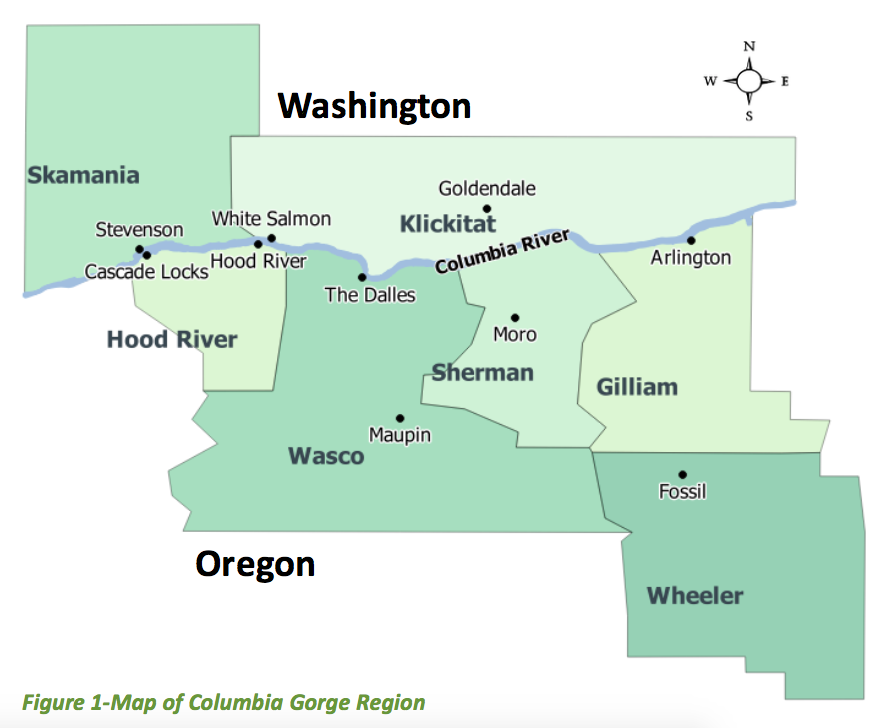
- 2016 Columbia Gorge Community Health Assessment
Community health needs and assessment: Priorities and process
- Food and diet-related disease priorities
- 2013 CHNA - Food insecurity
- 2016 CHNA - Food insecurity and healthy eating3
- Participation from food-based organizations in CHNA process
- Meals on Wheels, Next Door Inc., FISH Food Bank, Gorge Grown Food Network
- How/why did food issues emerge as a priority?
- A region-wide survey, both mailed and hand-administered, was conducted for the 2013 and 2016 CHNA. The survey consistently found high rates of food insecurity and was key in how food emerged as a CHNA priority area.
- Key community Indicators
- One in three persons in the region experience food insecurity. Those with lower incomes are almost 10 times more likely to go without food than those with higher incomes.
One-third (36%) of Hispanic or Latino respondents experienced food insecurity in the past year
Nearly two-thirds (65.2%) of Native Americans reported experiencing food insecurity
- One in three persons in the region experience food insecurity. Those with lower incomes are almost 10 times more likely to go without food than those with higher incomes.
Full assessment: 2016 Columbia Gorge Community Health Assessment
Assessing health needs—and how to meet them
Community health needs assessment process
In 2013, Providence Hood River Memorial Hospital took a lead role in developing the Columbia Gorge Health Council’s Regional Community Health Assessment. This regional effort brought together 14 partners including hospitals, public health departments, coordinated care organizations, and community organizations to conduct a collaborative assessment for a region that spans seven counties in Oregon and Washington. This rigorous, collaborative process was the catalyst for community discussions on health that have shaped Providence Hood River’s priorities, partnerships, and investments in the region.
In Oregon, Medicaid is organized into 16 Coordinated Care Organizations (CCOs) responsible for managing the needs — as well as federal dollars — for low-income patients. Unique to Oregon, is a statutory requirement that all CCOs must have a Community Advisory Committee (CAC) made up of at least 51 percent representation from Medicaid consumers. The advisory committees ensure that the community’s voice is reflected in health care policy and decisions and are responsible for approving a community needs assessment.
In the Columbia Gorge, the CAC includes representation from food-based community organizations such as Gorge Grown Food Network. These food organizations play a critical role in the Regional Community Health Assessment, including developing survey questions for the community survey, assisting with survey administration, and providing input on the Community Health Improvement Plan (CHIP).
Perhaps the most remarkable feature of Providence Hood River’s CHNA process is the significant resources dedicated to gathering primary data. To get a more granular look at the health needs of the community for the 2013 CHNA, the Columbia Gorge Regional Health Council launched a Community Health Survey that asked residents 72 questions ranging from health care access to transportation to food access.
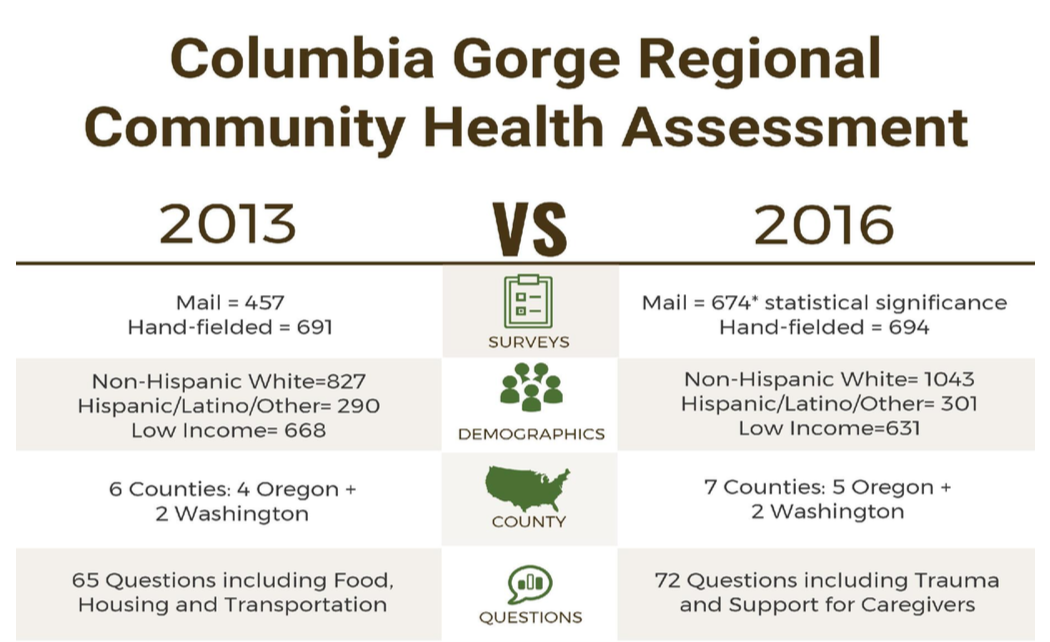
The results of this survey revealed a particularly troubling trend: one in three persons in Hood River were experiencing food insecurity.
In response to the alarming rates of food insecurity, this issue was prioritized in the Community Health Improvement Plan. As a step in that plan, a region-wide food survey was launched in 2013 and repeated in 2016 with the aim of further investigating food access and insecurity. The food survey included questions such as “did you skip a meal?” and “what makes it difficult to access food?” In both 2013 and 2016, surveys were mailed to over a thousand households and, in an effort to increase response rates from non-English-speaking, elderly and/or low-income households, over 600 surveys were hand-administered. In separate, but parallel data collection, Women, Infants, and Children (WIC) Food and Nutrition Service offices found regional trends showing high body mass index (BMI), high hunger, and poor nutrition among children.
This data not only helped researchers understand the demographics of hunger in the community, but also how much it would cost to meaningfully impact and eventually solve food insecurity.
- Mark Thomas, Director of Mission Integration and Spiritual Care for Providence Hood River
For Thomas, it makes economic sense to increase community resources to address healthy food access since the dollars needed to meet the community’s food needs is far lower—only about one percent of the current amount spent on health care for patients facing food insecurity.
The CHNA process prompted action from community leaders and community-based organizations with Providence Hood River leading many of these efforts.
Providence Oregon’s community benefit activities are organized under the Community Health Division, a 13-person department across eight regional hospitals. Among the network’s hospitals, Providence Hood River is a leader in community benefit, outspending its network hospitals on community health improvement investments as a percentage of operating expenses.
“We're often held up as an example of what community benefit is supposed to look like when it’s really running on all cylinders,” said Thomas.
From Gorge Grown on Vimeo.
Investing in solutions
Implementation strategy
In response to the region-wide CHNA findings, Providence Hood River has made significant investments of staff time, in-kind resources, and grant funding to programs working to address food insecurity. In 2015, Providence Hood River provided leadership and seed funding to form the Gorge Food Security Coalition. Another key investment has been PHR’s partnership with Gorge Grown’s Veggie Rx, a program that provides vouchers for fresh fruits and vegetables to persons experiencing food insecurity.
Project spotlights
Veggie Rx
This fruit and vegetable "prescription" program provides vouchers for fresh produce to community members who screen positive for food insecurity
- Program type: Fruit and vegetable prescription program
- Program administrator: Gorge Grown Food Network
- Program founded: 2015
- Hospital role: Provide grant support, provide staff or financial support for program evaluation
- Community partners: Over 35 regional health care and social service providers screen participants for program eligibility. Over 30 retail locations and farmers markets in the Columbia Gorge region redeem vouchers. Oregon State University provides nutrition and cooking classes to participants.
- Population served: Any person who screens positive for food insecurity
- Program goals: To increase purchasing power for families, increase fruit and vegetable consumption, and strengthen the regional food economy.
- Health needs addressed: Food security and healthy eating
- Key outcomes: Since 2015, the program has served approximately 10,000 individuals. From August 2015 to January 2016, the program issued $70,000 in vouchers.
Project description
The Veggie Rx Program is administered by Gorge Grown Food Network, a community-based organization in Hood River. Veggie Rx provides vouchers for fresh produce to community members who screen positive for food insecurity. Vouchers are prescribed and issued by health care and social service providers, which currently include 35 community partners in Women, Infants, and Children (WIC) Food and Nutrition Service offices, senior services offices, Head Start, Housing Authority, and health care facilities.
The screening process is based on a two-question screening instrument. If an individual screens positive, they receive $30 (three $10) prescription voucher packets to purchase fruits and vegetables. These are treated like cash at participating sites. Food-insecure families are eligible to receive voucher packets for every individual for up to three family members. Depending on the size of the family, providers can issue up to three $30 packets ($90 value) for three or more family members. Any individual or family can refill their prescription voucher once per month. One individual could potentially receive $360 in vouchers a year. A family of five could receive up to $1,080 per year. These vouchers are redeemable at more than 30 local retail partners including grocery stores and farmers markets.
Gorge Grown will also roll out a new Veggie Rx pilot in 2018 that will target expecting mothers experiencing economic hardship. Providence Hood River provided $35,000 to support the program, which will partner with WIC. This pilot is expected to yield rich comparative data on the impacts of Veggie Rx because WIC is able to compile and track participant data with greater detail and accuracy than most community-based organizations have the capacity to do.

Program participation
The only eligibility criteria for the Veggie Rx program is screening positive for food insecurity. Due to the large number of community partners who can conduct the screening and issue vouchers, the program has many entry points to reach a wider population.
Partnerships and hospital role
Providence Hood River provides funding for Veggie Rx. Since the program began in 2015, the health system has provided annual operational grants as well as funding for program evaluation. Providence’s research facility, The Center for Outcomes, Research and Education (CORE) in partnership with Next Door Inc., a community-based organization, conducted an evaluation of the program.
Oregon State University is another key partner that provides nutrition and cooking classes to participants. The program’s success is also due in part to their partnership with the more than 30 local farmers markets and grocers where participants can redeem vouchers for fruit and vegetables.
Financing
Providence Hood River provided seed funding for the 2015 Veggie Rx pilot and $22,000 to fund a program evaluation. Veggie Rx has received a total of $170,000 since 2015 with the majority of funding coming from One Community Health (a federally qualified health center), Oregon Community Foundation, Providence Hood River, Columbia Gorge Health Council (the regional Coordinated Care Organization governance body), other local foundations, and individual donors.8 Although large funding was required for initial development and implementation, operational costs have declined now that the program is established. Program coordination only requires one part-time staff member. Program sustainability, however, continues to be a challenge since voucher costs remain high.
Gorge Grown has also recently secured funding through PacificSource, the regional Coordinated Care Organization for the Columbia Gorge and surrounding counties. These organizations manage the state of Oregon’s Medicaid program and are funded by Medicaid dollars. PacificSource has allocated $10,000 for Veggie Rx through their “flexible service” funding stream starting in June 2017. Gorge Grown’s Veggie Rx is one of the first programs of its kind to receive this type of funding from CCOs for food prescriptions. This one-time funding was provided on a trial basis and whether or not it will continue is still uncertain. The question remains as to whether CCOs will continue to dedicate funds for fruit and vegetable prescription programs on a consistent basis. For these types of programs, CCOs are an important revenue source to help stabilize the program’s funding stream.
Program evaluation and impacts
Providence Hood River funded a community-based participatory research study led by The Next Door Inc., a community-based organization, and the Providence Center for Outcomes, Research, and Education. The study evaluated three cohorts (in English and Spanish) using Photovoice, a research tool that provides participants with cameras to document experiences and stories. Participants reported positive health, diet, and economic outcomes and provided insights that informed program adjustments to improve access and redemption rates.
Gorge Grown conducted a separate internal evaluation to assess screening, distribution, redemption rates, and identify hunger “hotspots” in the community. From August 2015 through January 2016, the program issued $70,000 of vouchers. Since the program started, Veggie Rx has provided vouchers to approximately 2,500 participants and screened 6,900 individuals. Thirty-three percent of those screened were positively identified as food insecure. Since many individuals receiving vouchers apply for family benefits, the impact of the program is difficult to track but is estimated to help feed about 10,000 Columbia Gorge residents. The program does not track individual data, only aggregated vouchers issued by each participating clinic/screening site.
Lessons learned
During the initial year of the program, redemption rates remained low (at around 60 percent) for participants. A key lesson learned is the importance of a large network of redemption sites for vouchers; increasing the number of farmers markets and grocers that accept vouchers dramatically increased voucher redemption. Challenges for the program remain. Participants cite stigma around using vouchers as a key barrier as well as the difficulties in accessing screening sites.
According to Thomas, another key lesson learned was the importance of evaluation as a mechanism for programs to secure additional funding. The funding for the Photovoice study was provided with the explicit hope that it would help Gorge Grown collect data on participants’ outcomes that could help make a compelling case to funders for continued support of the program. However, more quantitative evaluation to demonstrate sustained improved health outcomes will be necessary to convince funders, particularly health insurance companies, to make a meaningful investment in the program.
Gorge Security Food Coalition
The Gorge Food Security Coalition brings together stakeholders to work collaboratively to address food insecurity.
- Program type: Coalition/community collaboration
- Program administrator: Gorge Grown Food Network
- Program founded: 2016
- Hospital role: Provide grant support, provide use of hospital facilities
- Community partners: the State of Oregon provided funding and support to facilitate the creation of the coalition. Providence Hood River is a key supporter and participant. Gorge Grown provides manages personnel and administrative support for the coalition manager.
- Program goals: To convene stakeholders, identify community strengths, and develop partnerships to strengthen the local food system and address gaps and barriers to healthy food access.
- Health needs addressed: Food security and healthy eating
- Key outcomes: The coalition has helped convene and connect community stakeholders to identify and work on solutions to food issues.
Program description
Providence Hood River, along with other regional partners, founded the Gorge Food Security Coalition to bring together stakeholders to work collaboratively to address food insecurity. Any and all organizations and individuals are invited to participate in the coalition.
The coalition brings together 30 members working across the food system. Projects of the coalition include:
Conducting an inventory of direct service providers in the region
Working to identify gaps in infrastructure
Identifying and developing work groups/steering committees to lead projects
Liz Oberhausen, the Food Coalition Program Manager, describes the efforts of the coalition as an informal platform for organizations to engage and collaborate.
As the manager, Oberhausen’s role includes bringing intervention opportunities to stakeholders. For example, when Candy Armstrong, the Wasco County superintendent, heard of the high rates of food insecurity facing students in her district, she reached out to Oberhausen for assistance in identifying and implementing a project. Oberhausen worked with The Next Door Inc., a community-based organization in Hood River City, to replicate the work of the Oregon Food Bank in creating a mobile market site for students. As a result of these efforts, a mobile pantry opened in 2017 to serve Wasco students.
Partnerships and hospital role
The Food Security Coalition was born out of community discussions led by Partners for a Hunger Free Oregon in 2015. In 2016, a steering committee with representatives from the health care sector, Oregon Food Bank, Gorge Grown Food Network, and the Columbia Gorge Health Council, applied for and received support to the Office of the Governor. The Governor approved the project’s designation as an “Oregon Solutions” project, which provided support, funding, and formal facilitation from trained experts for the group to identify goals.
Mark Thomas from Providence Hood River served as “Convener,” a Governor-appointed position that serves as a neutral chair for the project during the facilitation process. Thomas continues to serve as an active member. Providence Hood River, in addition to providing significant staff involvement, supports the work of the coalition by providing meeting space and a $1,000 match to remove barriers to participation, such as by providing childcare at meetings for community members.
Financing
The program manager position was funded in 2017 by Providence Hood River, The Collins Foundation, and the Oregon Community Foundation. The position is funded through 2018 by Meyer Memorial Trust. There are ongoing efforts to secure funding for the program manager through 2020.
Program evaluation and impacts
Providence Hood River tracks goals and outcomes for the program manager position. Short-term goals of the coalition include convening stakeholders, identifying community strengths, and developing partnerships to strengthen the local food system and address gaps and barriers to healthy food access. Success for the coalition means developing sustainable and highly collaborative approaches to addressing food insecurity in the Gorge region. There has been no formal evaluation of the program.
Lessons learned
Oberhausen is adamant that there is no “one size fits all” solution—every community is different. In her time as coalition manager, Oberhausen has learned that patience and listening are the key ingredients to building a successful coalition. While many of the projects move slower than she would like, the strength of the alliance is the continuing discussion and sharing that happens among members.
However, Oberhausen believes that in the Gorge, much of the success of the food work can be attributed to the strong involvement of health care. Having Providence Hood River as a champion from the start was critical to the success of forming a strong coalition.
Thomas, however, sees the principal strength of the coalition in its community-led nature. At the core of their efforts is the recognition that Providence Hood River can’t tackle the problem alone.
Thomas believes that one of the greatest contributions Providence Hood River can make is as a convener. Although the hospital was a key early supporter, Thomas has chosen to “deliberately not lead” the group so that there is space for other leaders to emerge.
Raices Cooperative Farm Program
This co-op farm teaches organic gardening in Spanish and offers free farmland to community members.
- Program type: Cooperative farm
- Program administrator: The Next Door Inc.
- Program founded: 2010
- Hospital role: Provide grant support
- Community partners: Presbyterian Committee on the Self-Development of People, local landowners
- Population served: Spanish-speaking community members
- Program goals: To increase the amount of organic produce available to members and to improve members’ health through physical activity and healthy food consumption.
- Health needs addressed: Food security and healthy eating
- Key outcomes: The program serves approximately 100 individuals per year. Participants have reported increased access to healthy food and improved the health of their families as a result of the program.
Program description
The Raices/Roots Cooperative Farm offers Spanish-speaking community members with the opportunity to engage with farming and build leadership skills. The program offers classes and workshops to teach organic gardening skills and offers garden space to members who do not have access to land.
The objectives of the Raices program are to increase the amount of organic produce available to members and to improve members’ health through physical activity and healthy food consumption. In the long term, the program hopes to instill gardening and healthy food knowledge that improve the health of the Latino community in the region.
Program participation
The program is open to all community members but is largely limited to Spanish-speakers since all instruction is provided in Spanish. Members must commit 10 hours of community service to the garden, pay an annual membership fee of $20, and attend three meetings per year. Members receive garden space and access to the communal toolshed.
Collaboration and financing
The Next Door Inc. received an $18,000 grant from Providence Hood River in 2015 for the Raices Cooperative Farm program. Providence Hood River also provided in-kind staff support to assist with the program evaluation. The Raices Cooperative Farm Program is largely funded by private foundations, the Presbyterian Committee on the Self-Development of People, and community benefit dollars from Providence Hood River. Key partners include local landowners who lease free land to participants for farming. An annual plant sale also helps raise funds for the program.
Program evaluation and impacts
The Raices Cooperative Farm serves approximately 27 families or 100 individuals per year. In 2015, the program conducted a survey of members to assess the impacts of the farm on fruit and vegetable consumption. The survey found that program members harvested a total of 515 five-gallon buckets of produce from their gardens. A total of 161 people were fed from produce grown in the program and an overwhelming majority of members felt that the program increased access to healthy food and improved the health of the gardeners and their families.
In 2016, Providence Hood River provided support to help the program develop a more rigorous evaluation at the request of Jody O’Connor, the Economic Development Services Manager for Raices Cooperative Farm. O’Connor wanted an evaluation that would help her improve the program in a more strategic way. In addition to funding, Providence Hood River also provided in-kind support from the Center for Outcomes, Research, and Education, the hospital’s evaluation center. The evaluation is still being developed.
Lessons learned
For Mark Thomas, a key lesson Providence Hood River has learned over years of supporting the efforts of community-based organizations is the need for evaluations that can demonstrate impact. These evaluations are critical in supporting fundraising efforts and making a strong case to funders regarding the importance of such programs. Given its limited community benefit dollars, the best investment Providence Hood River can make is to provide organizations a way to leverage hospital grants to raise additional revenue. In this way, Providence Hood River can maximize their impact to support programs making a difference in the community.
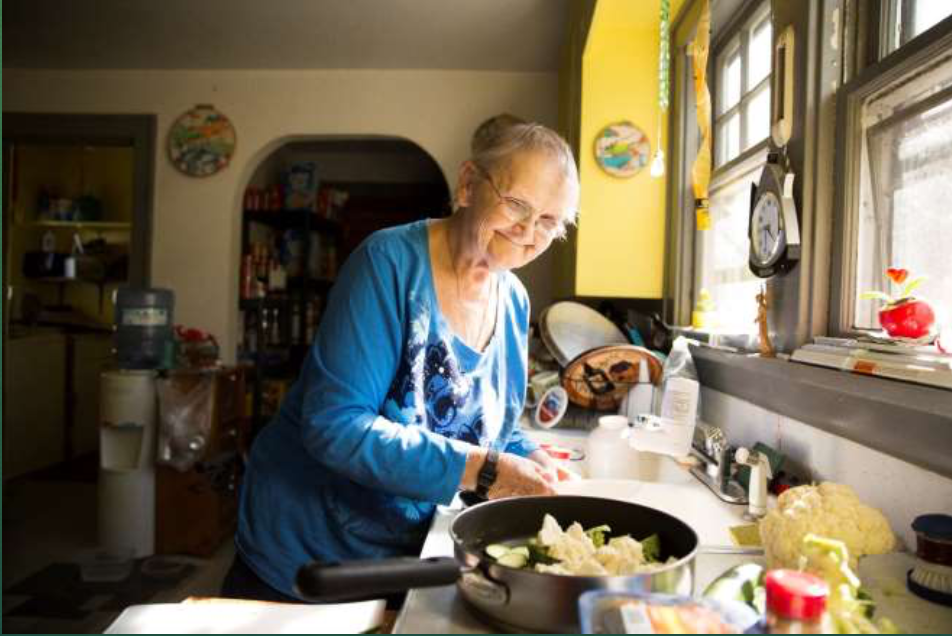
Ongoing work
Providence Hood River participated in the recently completed 2017 Columbia Gorge Community Health Improvement Plan. Healthy food access, obesity, and food insecurity continue to be important issues for the area. Providence Hood River also continues to support regional projects that support healthy food access for its most vulnerable community members. These include the following new and developing projects:
- Oregon Food Bank expansion - The Oregon Food Bank, which represents a statewide regional network of food banks and pantries, opened its newest warehouse site in December 2017 to serve the Columbia Gorge region. The warehouse will distribute food to regional pantries, which previously relied on deliveries coming from Portland, Oregon. Deliveries were frequently delayed or unable to reach the area in severe weather. Providence Hood River provided $35,000 in funding to support the opening of new pantry sites, which will receive food distributions from the warehouse and expand healthy food access for communities facing food insecurity.
- Promoting healthy behaviors - Providence Hood River provided support for Pasos Para la Familia, a chronic disease prevention program that teaches nutrition education, exercise, and stress management to families and is offered in Spanish. They also provided support for Youth Fit for Life, a new afterschool physical activity program at Mid-Valley Elementary School in Hood River City.
In recognition of the significant efforts to address health disparities and hunger, the Gorge community received the 2016 Robert Wood Johnson Culture of Health Prize. A key supporter and champion for much of the work happening in the region is Providence Hood River Memorial Hospital.
From their efforts to survey hard-to-reach populations to their funding for numerous healthy food and food security initiatives, Providence Hood River has made significant investments and commitments to listen to and respond to the needs of their community's most vulnerable populations.
- Mark Thomas, Director of Mission Integration and Spiritual Care for Providence Hood River


